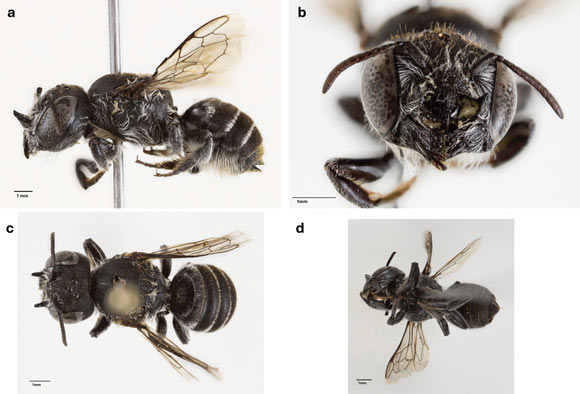The newly-discovered bee species belongs to the genus Megachile and is a visitor to a critically endangered flowering plant species called Marianthus aquilonaris.

The new Megachile species. Image credit: Kit Prendergast & Joshua Campbell, doi: 10.3897/jhr.98.166350.
Australia is facing a pollination crisis, with related crises relating to a lack of information on the pollinators of plants, and the taxonomic impediment.
For many critically endangered plants, their visitors are unknown, jeopardising our ability to conserve their populations.
The Australian native bee fauna is also threatened by a lack of monitoring, and many regions have not been surveyed, whilst many native bees remain undescribed.
The new Megachile bee species was found during surveys of Marianthus aquilonarius that grows only in the Bremer Range region in Western Australia.
“I discovered the species while surveying a rare plant in the Goldfields and noticed this bee visiting both the endangered wildflower and a nearby mallee tree,” said Dr. Kit Prendergast, a researcher at the University of Southern Queensland and Curtin University.
“DNA barcoding confirmed the male and female were the same species and that it didn’t match any known bees in DNA databases, nor did the specimens I had collected morphologically match any in museum collections.”
“It’s the first new member of this bee group to be described in more than 20 years, which really shows how much life we still have to discover — including in areas that are at risk of mining, such as the Goldfields.”
The discovery of the new Megachile species highlights the importance of understanding Australian native bees before their habitats are disturbed.
“Because the new species was found in the same small area as the endangered wildflower, both could be at risk from habitat disturbance and other threatening processes like climate change,” Dr. Prendergast said.
“Many mining companies still don’t survey for native bees, so we may be missing undescribed species, including those that play crucial roles in supporting threatened plants and ecosystems.”
“Without knowing which native bees exist and what plants they depend on, we risk losing both before we even realize they’re there.”
The discovery is reported in a paper published this week in the Journal of Hymenoptera Research.







